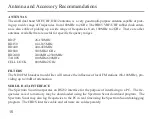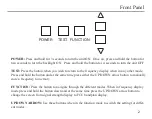
14
The Spectrum Scout is similar to other nearfield devices in the way it locks onto RF signals. It is look-
ing for a dominant nearfield signal that is 15dB above the background RF level. As it detects a domi-
nant signal a frequency is displayed.
Background RF levels have a large impact on how far away the Spectrum Scout can lock onto signals.
The higher the background RF levels the closer the Spectrum Scout will need to be to detect a signal.
The lower the background RF the further the Spectrum Scout can be to detect a signal. For instance,
when in a metropolitan area the background RF levels are much higher than in a rural area. Therefore,
a 5 watt UHF radio that can be detected from around 200 feet in a normal RF environment may well
need to be within 100 feet or less in a high RF environment.
High power transmitters such as FM stations, TV stations, Paging towers etc.. have an adverse influ-
ence on the way a frequency counter works. Even if the Spectrum Scout does not lock onto and display
the frequency of your local radio station that does not mean that it is not influenced by the RF. Because
the RF is still present the Optoelectronics N100 FM notch filter should be a consideration. The N100
provides 30dB of attenuation in the FM band. Knocking down the background RF by 30dB will allow
the Spectrum Scout to see that 15dB signal from a greater distance. This is not to say it will not work
in high RF areas, however it is something that should be taken into account.
Using different antennas also plays a large role in the effectiveness of the Spectrum Scout. Experiment
with different antennas for different applications and you will be surprised at the varying results. See
page 15 for a list of accessory antennas.
What to Expect






































